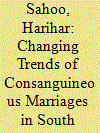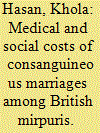| Srl | Item |
| 1 |
ID:
183683


|
|
|
|
|
| Summary/Abstract |
Consanguineous marriage is still a preferred option in many societies of southern India. Therefore, this study addresses the state and district wise variation in consanguineous marriages and also attempts to find out the underlying factors of this practice in different marriage cohorts of South India. Drawing data from National Family Health Survey-4, the result revealed that there is a reduction in consanguineous marriages from 32.6% who married before 1985 to 23% during 2010–2014. About 13 districts in Tamil Nadu had the highest prevalence of consanguineous marriages, indicating that recent socio-demographic changes such as delays in age at marriages, lesser age gaps between partners, increase in the level of education, etc., did not explicitly affect the consanguineous marriages.
|
|
|
|
|
|
|
|
|
|
|
|
|
|
|
|
| 2 |
ID:
091735


|
|
|
|
|
| Publication |
2009.
|
| Summary/Abstract |
Consanguineous marriage has been widespread within the Pakistani Mirpuri community in Britain today. Such marriage arrangements are now increasingly perceived to create various problems and harms, including a high degree of insularity with barriers to integration and lack of contact with the wider community. Many instances of forced marriage give rise to human rights concerns. Since such marriages are often arranged with partners from Pakistan to aid the extended family financially, large-scale immigration from Pakistan into Britain continues. Many of these new spouses cannot speak English and are unfamiliar with English culture, which continues to slow down the pace of integration of Mirpuris. The article highlights particularly that the rates of consanguineous marriage are increasing within this particular community despite awareness of the medical risks involved, including an increase in congenital defects and infant mortality. Serious and culturally sensitive thought needs to be given on all sides, therefore, to addressing such issues rather than infl ating controversies and damaging community relations.
|
|
|
|
|
|
|
|
|
|
|
|
|
|
|
|